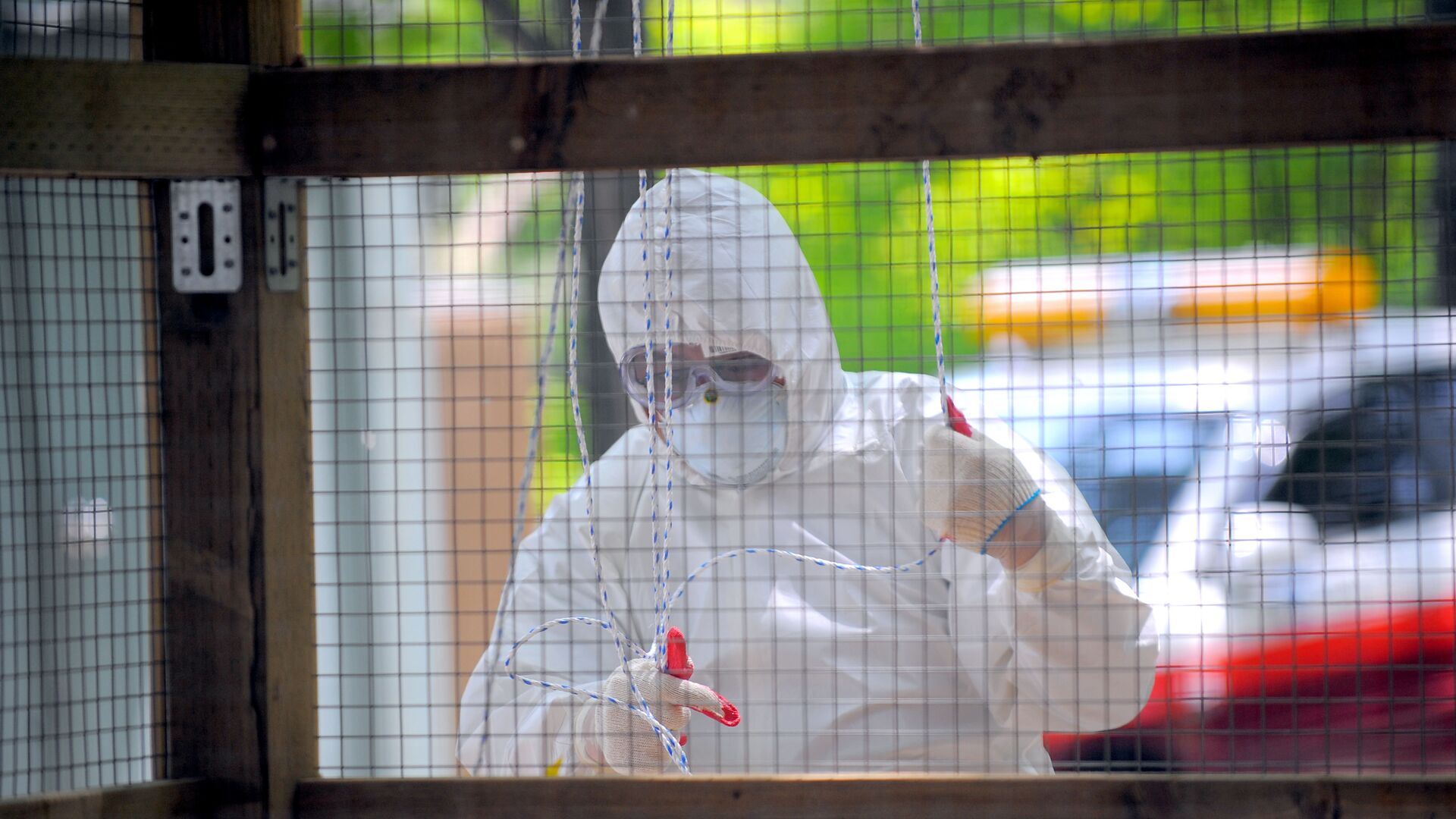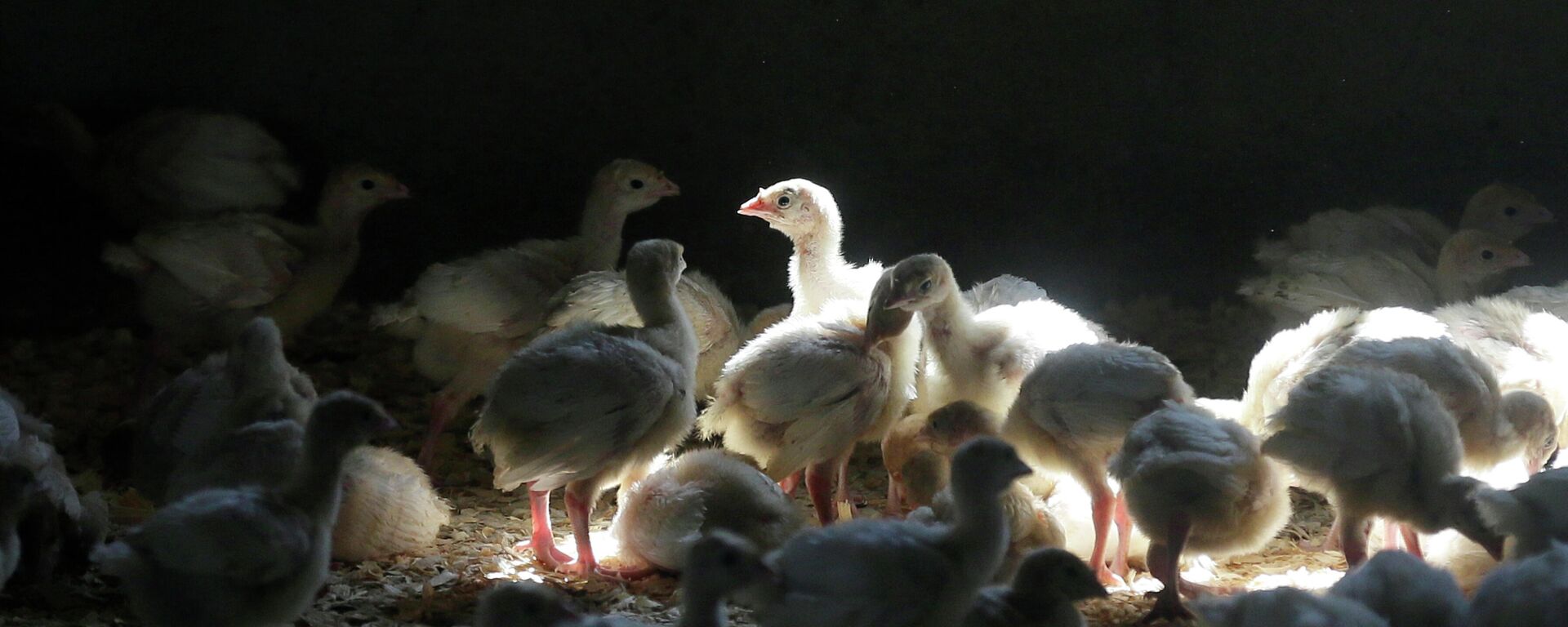https://sputnikglobe.com/20220407/bird-flu-precautions-shutting-down-zoo-displays-1094532129.html
Bird Flu Precautions Shutting Down Zoo Displays
Bird Flu Precautions Shutting Down Zoo Displays
Sputnik International
More than 50 million birds died due to the 2015 outbreak of avian influenza, better known as bird flu. The disease is spreading again among birds across the... 07.04.2022, Sputnik International
2022-04-07T01:55+0000
2022-04-07T01:55+0000
2022-04-07T01:55+0000
bird flu
zoo
avian flu
https://cdn1.img.sputnikglobe.com/img/103700/21/1037002159_0:27:3756:2140_1920x0_80_0_0_9b22d7111312514483464527362dfe5e.jpg
Bird displays in zoos across the nation are being shuttered in an attempt to prevent the spread of the highly contagious H5N1 strain of bird flu.Already, 23 million chickens and turkeys have been euthanized in the US in an attempt to slow the spread of bird flu, though most were uninfected, authorities require that entire flocks be culled in commercial poultry when an animal tests positive for the disease.That would be a last ditch effort in the case of zoos. The US Department of Agriculture has indicated that zoos can try to isolate or euthanize infected birds without killing every bird in an enclosure.So far, no cases have been reported at zoos but given the speed the virus spreads, zookeepers are taking abundant precautions.The primary goal of closing bird displays is not because humans pose a large threat to the birds or vice versa. Bird flu is spread through bird droppings and nasal discharge. Humans can spread it by getting dropping on their boots or equipment when moving from enclosure to enclosure but the main concern is keeping wild birds out of enclosures and preventing them from mingling with zoo display birds.The best way to keep wild and zoo birds apart is to move the captive birds inside, but in cases where that isn’t possible zoos are adding roofs to enclosures, making sure netting is secure, and keeping birds in smaller groups to limit the spread when one does get infected.Unlike the 2015 bird flu outbreak, which the USDA called the “the largest poultry health disaster in U.S. history” this outbreak is affecting wild birds in far greater numbers. The first detected incident was in a wild bird and that trend has continued.The Raptor Center in St. Paul, Minnesota cares for injured and sick “Raptor” birds, also known as birds of prey and they are seeing more infected birds than in the 2015 outbreak.Hall says the public can help prevent the spread of bird flu by removing bird feeders because they encourage birds to mingle together.There have been no confirmed cases of this strain of bird flu in humans in the United States and the Center of Disease Control stresses that the risk to humans remains very low. Poultry and eggs are still safe to eat as long as they are cooked to the recommended internal temperature of 165 F (74C).
https://sputnikglobe.com/20220321/south-dakota-euthanizes-85000-birds-as-us-state-faces-first-avian-flu-outbreaks-since-2015-1094066681.html
Sputnik International
feedback@sputniknews.com
+74956456601
MIA „Rossiya Segodnya“
2022
News
en_EN
Sputnik International
feedback@sputniknews.com
+74956456601
MIA „Rossiya Segodnya“
Sputnik International
feedback@sputniknews.com
+74956456601
MIA „Rossiya Segodnya“
bird flu, zoo, avian flu
Bird Flu Precautions Shutting Down Zoo Displays
More than 50 million birds died due to the 2015 outbreak of avian influenza, better known as bird flu. The disease is spreading again among birds across the globe, but health experts say the threat to humans is very low.
Bird displays in zoos across the nation are
being shuttered in an attempt to prevent the spread of the highly contagious H5N1 strain of bird flu.
Already, 23 million chickens and turkeys have been euthanized in the US in an attempt to slow the spread of bird flu, though most were uninfected, authorities require that entire flocks be culled in commercial poultry when an animal tests positive for the disease.
That would be a last ditch effort in the case of zoos. The US Department of Agriculture has indicated that zoos can try to isolate or euthanize infected birds without killing every bird in an enclosure.
So far, no cases have been reported at zoos but given the speed the virus spreads, zookeepers are taking abundant precautions.
The primary goal of closing bird displays is not because humans pose a large threat to the birds or vice versa. Bird flu is spread through bird droppings and nasal discharge. Humans can spread it by getting dropping on their boots or equipment when moving from enclosure to enclosure but the main concern is keeping wild birds out of enclosures and preventing them from mingling with zoo display birds.
The best way to keep wild and zoo birds apart is to move the captive birds inside, but in cases where that isn’t possible zoos are adding roofs to enclosures, making sure netting is secure, and keeping birds in smaller groups to limit the spread when one does get infected.
Unlike the 2015 bird flu outbreak, which the USDA called the “the largest poultry health disaster in U.S. history” this outbreak is affecting wild birds in far greater numbers. The first detected incident was in a wild bird and that trend has continued.
The Raptor Center in St. Paul, Minnesota cares for injured and sick “Raptor” birds, also known as birds of prey and they are seeing more infected birds than in the 2015 outbreak.
“In 2015 we had a lot of cases of highly pathogenic avian influenza, but it was mostly in commercial poultry operations. We did not see this level in wildlife.” Victoria Hall, the executive director of the Raptor Center told a local news outlet “We didn't have a single case here at The Raptor Center and we've already seen seven in our first couple of days of testing here. So very, very different and we're seeing a lot more illness and suffering in these guys when they catch it." Hall says the public can help prevent the spread of bird flu by removing bird feeders because they encourage birds to mingle together.
There have been no confirmed cases of this strain of bird flu in humans in the United States and the Center of Disease Control stresses that the risk to humans remains very low. Poultry and eggs are still safe to eat as long as they are cooked to the recommended internal temperature of 165 F (74C).


